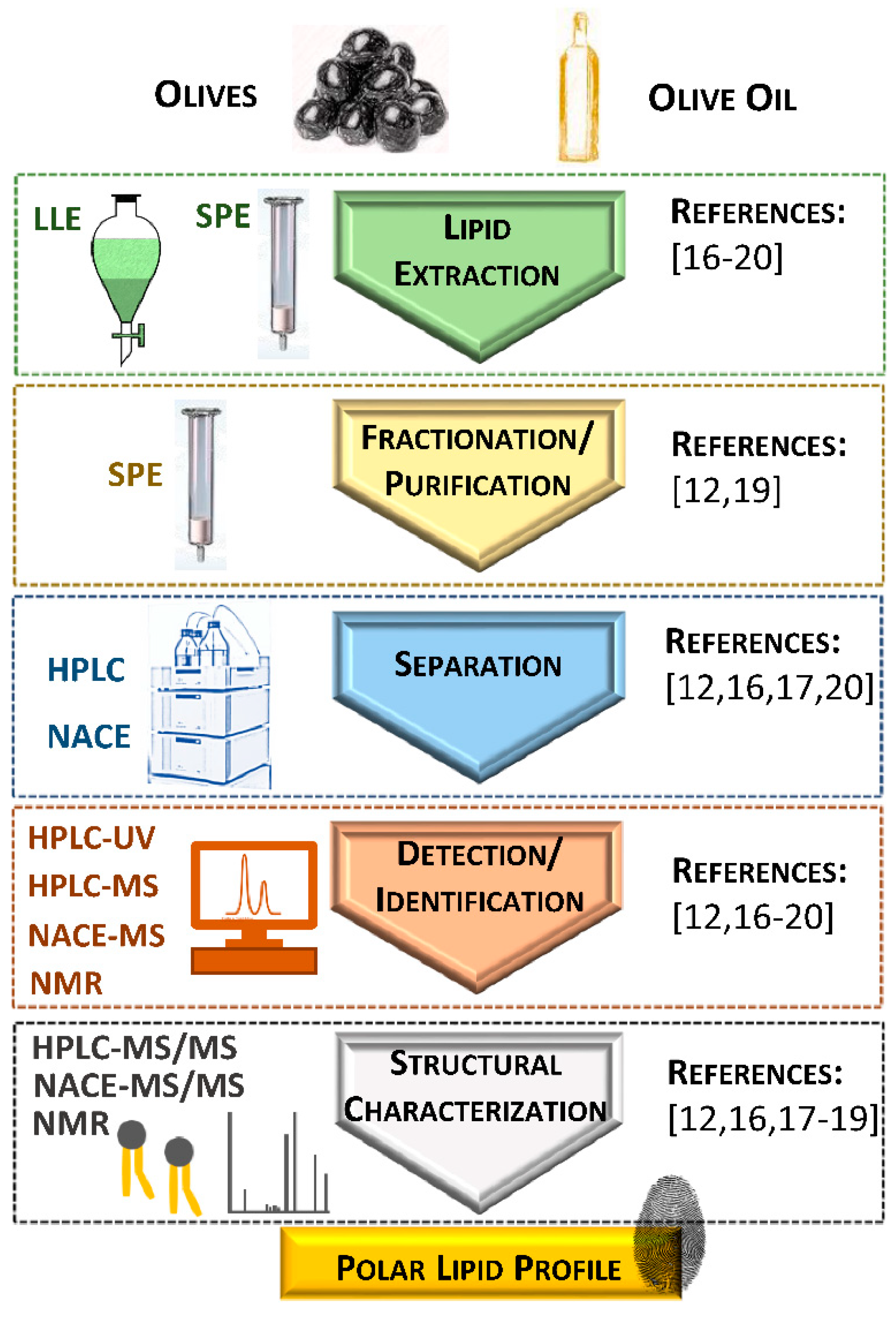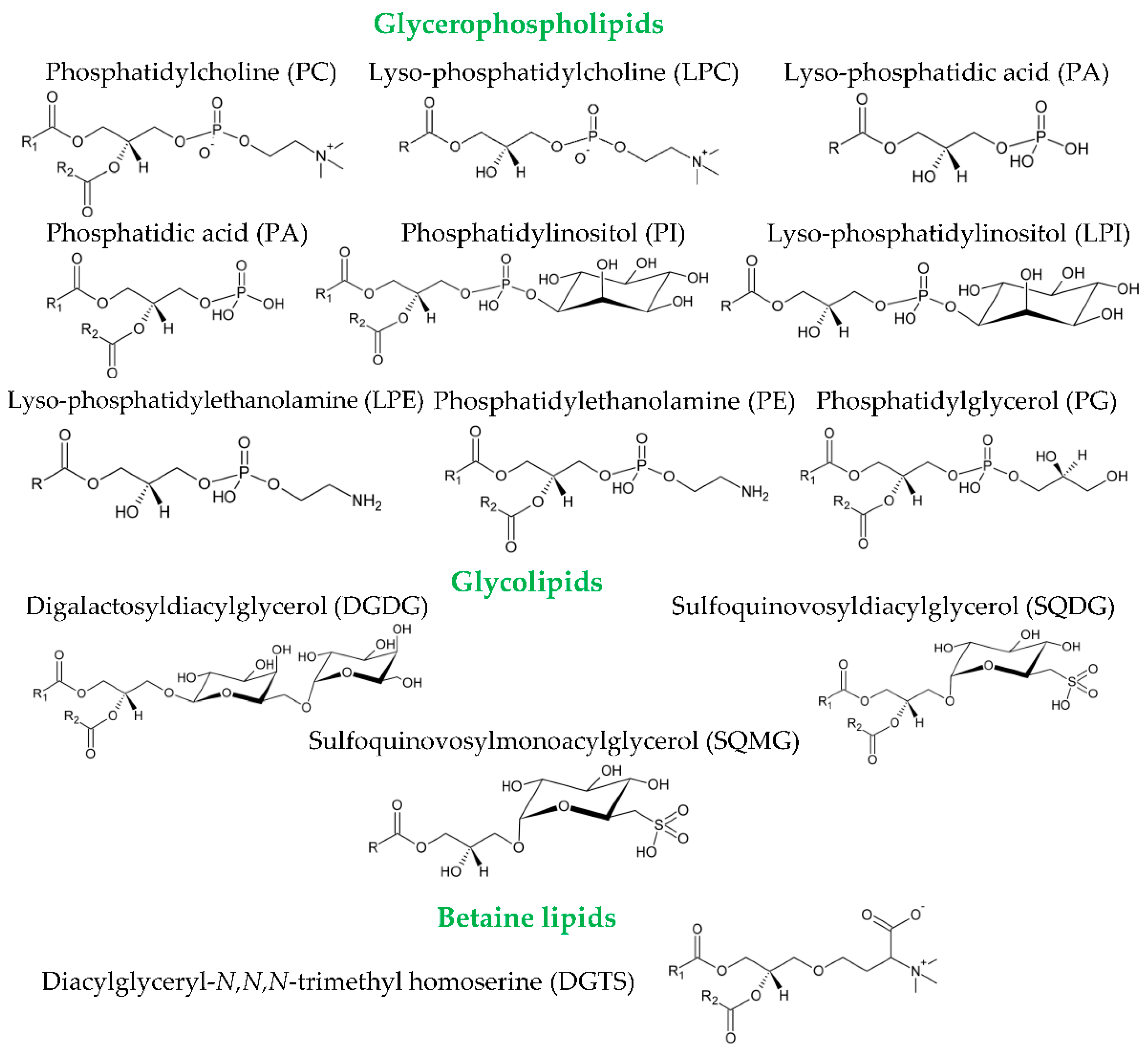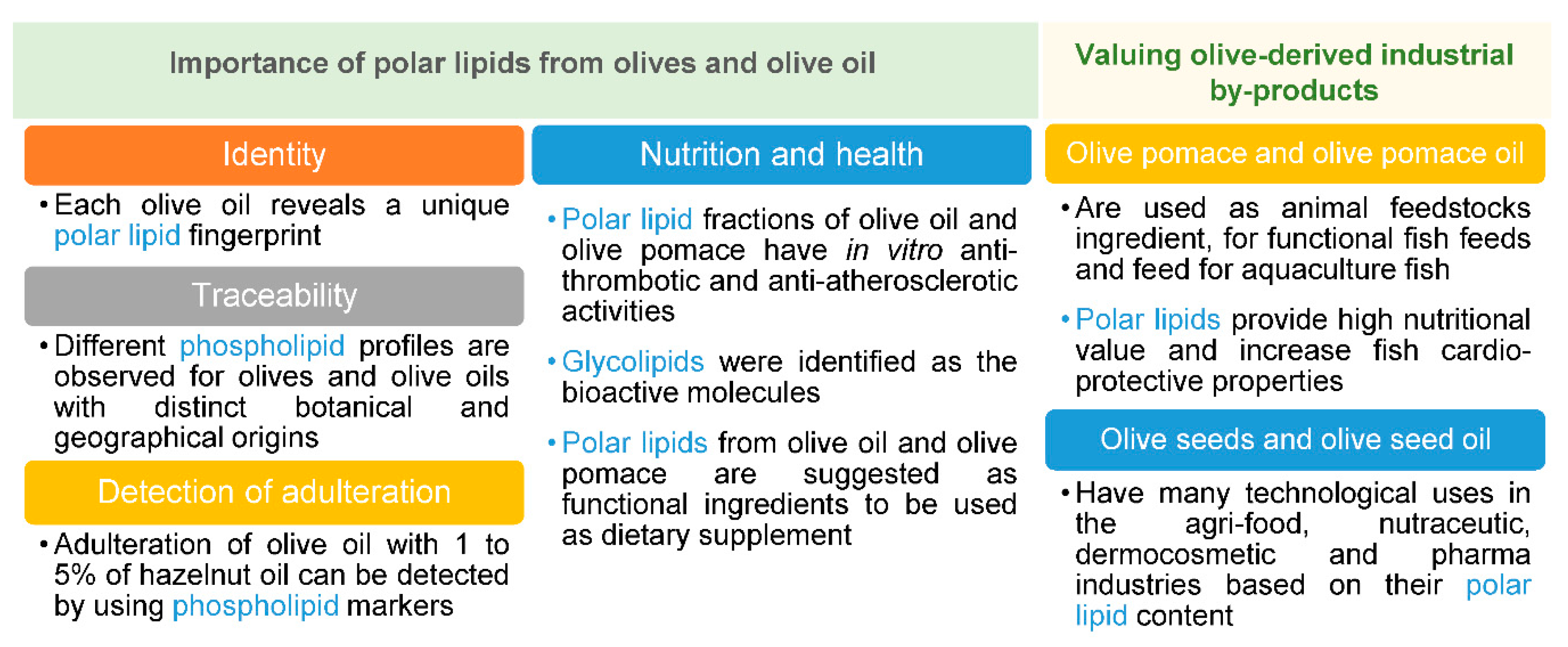Polar Lipids from Olives and Olive Oil: A Review on Their Identification, Significance and Potential Biotechnological Applications
Abstract
1. Introduction
2. Identification of Polar Lipids from Olives, Olive Oil, and Their Industrial By-Products
Analytical Challenges in Identifying Polar Lipids in Olives and Olive Oil
3. The Importance of Studying Polar Lipids from Olives and Olive Oil
3.1. Authentication, Traceability, and Detection of Adulteration
3.2. Nutrition and Health
4. Potential Biotechnological Uses of Polar Lipids from Olives’ and Olive Oil’s Industrial By-Products
5. Conclusions and Future Perspectives
Author Contributions
Funding
Conflicts of Interest
References
- International Olive Council. World Olive Oil Figures. Available online: http://www.internationaloliveoil.org/estaticos/view/131-world-olive-oil-figures (accessed on 18 December 2017).
- Boskou, D. 1-Olive oil: Properties and processing for use in food. In Specialty Oils and Fats in Food and Nutrition, 1st ed.; Talbot, G., Ed.; Woodhead: Cambridge, UK, 2015; pp. 3–38. ISBN 9781782423768. [Google Scholar]
- Schwingshackl, L.; Hoffmann, G. Monounsaturated fatty acids and risk of cardiovascular disease: Synopsis of the evidence available from systematic reviews and meta-analyses. Nutrients 2012, 4, 1989–2007. [Google Scholar] [CrossRef] [PubMed]
- Campestre, C.; Angelini, G.; Gasbarri, C.; Angerosa, F. The compounds responsible for the sensory profile in monovarietal virgin olive oils. Molecules 2017, 22, 1833. [Google Scholar] [CrossRef] [PubMed]
- Servili, M.; Esposto, S.; Fabiani, R.; Urbani, S.; Taticchi, A.; Mariucci, F.; Selvaggini, R.; Montedoro, G. Phenolic compounds in olive oil: Antioxidant, health and organoleptic activities according to their chemical structure. Inflammopharmacology 2009, 17, 76–84. [Google Scholar] [CrossRef] [PubMed]
- Aparicio, R.; Conte, L.S.; Fiebig, H.-J. Chapter 16. Olive oil authentication. In Handbook of Olive Oil: Analysis and Properties; Aparicio, R., Harwood, J., Eds.; Springer: Boston, MA, USA, 2013; pp. 589–5654. ISBN 978-1-4614-7777-8. [Google Scholar]
- Perri, E.; Benincasa, C.; Muzzalupo, I. Chapter 13. Olive oil traceability. In Olive Germplasm-the Olive Cultivation, Table Olive and Olive Oil Industry in Italy; Muzzalupo, I., Ed.; InTechOpen: London, UK, 2012; pp. 265–286. ISBN 978-953-51-0883-2. [Google Scholar]
- Montealegre, C.; Marina Alegre, M.L.; García-Ruiz, C. Traceability markers to the botanical origin in olive oils. J. Agric. Food Chem. 2010, 58, 28–38. [Google Scholar] [CrossRef] [PubMed]
- Aparicio, R.; Morales, M.T.; Aparicio-Ruiz, R.; Tena, N.; García-González, D.L. Authenticity of olive oil: Mapping and comparing official methods and promising alternatives. Food Res. Int. 2013, 54, 2025–2038. [Google Scholar] [CrossRef]
- Gallina Toschi, T.; Bendini, A.; Lozano-Sánchez, J.; Segura-Carretero, A.; Conte, L. Misdescription of edible oils: Flowcharts of analytical choices in a forensic view. Eur. J. Lipid Sci. Technol. 2013, 115, 1205–1223. [Google Scholar] [CrossRef]
- Bajoub, A.; Bendini, A.; Fernández-Gutiérrez, A.; Carrasco-Pancorbo, A. Olive oil authentication: A comparative analysis of regulatory frameworks with especial emphasis on quality and authenticity indices, and recent analytical techniques developed for their assessment. A review. Crit. Rev. Food Sci. Nutr. 2018, 58, 832–857. [Google Scholar] [CrossRef] [PubMed]
- Alves, E.; Melo, T.; Rey, F.; Moreira, A.S.; Domingues, P.; Domingues, M.R. Polar lipid profiling of olive oils as a useful tool in helping to decipher their unique fingerprint. LWT Food Sci. Technol. 2016, 74, 371–377. [Google Scholar] [CrossRef]
- Calvano, C.D.; De Ceglie, C.; D’Accolti, L.; Zambonin, C.G. MALDI-TOF mass spectrometry detection of extra-virgin olive oil adulteration with hazelnut oil by analysis of phospholipids using an ionic liquid as matrix and extraction solvent. Food Chem. 2012, 134, 1192–1198. [Google Scholar] [CrossRef] [PubMed]
- Karantonis, H.C.; Antonopoulou, S.; Demopoulos, C.A. Antithrombotic lipid minor constituents from vegetable oils. Comparison between olive oils and others. J. Agric. Food Chem. 2002, 50, 1150–1160. [Google Scholar] [CrossRef] [PubMed]
- Tsantila, N.; Karantonis, H.C.; Perrea, D.N.; Theocharis, S.E.; Iliopoulos, D.G.; Antonopoulou, S.; Demopoulos, C.A. Antithrombotic and antiatherosclerotic properties of olive oil and olive pomace polar extracts in rabbits. Med. Inflamm. 2007, 2007, 11. [Google Scholar] [CrossRef] [PubMed]
- Boukhchina, S.; Sebai, K.; Cherif, A.; Kallel, H.; Mayer, P.M. Identification of glycerophospholipids in rapeseed, olive, almond, and sunflower oils by LC-MS and LC-MS-MS. Can. J. Chem. 2004, 82, 1210–1215. [Google Scholar] [CrossRef]
- Montealegre, C.; Sanchez-Hernandez, L.; Crego, A.; Marina, M. Determination and characterization of glycerophospholipids in olive fruit and oil by nonaqueous capillary electrophoresis with electrospray-mass spectrometric detection. J. Agric. Food Chem. 2013, 61, 1823–1832. [Google Scholar] [CrossRef] [PubMed]
- Hatzakis, E.; Koidis, A.; Boskou, D.; Dais, P. Determination of phospholipids in olive oil by 31P-NMR spectroscopy. J. Agric. Food Chem. 2008, 56, 6232–6240. [Google Scholar] [CrossRef] [PubMed]
- Verardo, V.; Gómez-Caravaca, A.; Montealegre, C.; Segura-Carretero, A.; Caboni, M.; Fernández-Gutiérrez, A.; Bendini, A. Optimization of a solid phase extraction method and hydrophilic interaction liquid chromatography coupled to mass spectrometry for the determination of phospholipids in virgin olive oil. Food Res. Int. 2013, 54, 2083–2090. [Google Scholar] [CrossRef]
- Bianco, A.; Mazzei, R.A.; Melchioni, C.; Scarpati, M.L.; Romeo, G.; Uccella, N. Microcomponents of olive oil. Part II: Digalactosyldiacylglycerols from Olea europaea. Food Chem. 1998, 62, 343–346. [Google Scholar] [CrossRef]
- Koidis, A.; Boskou, D. The contents of proteins and phospholipids in cloudy (veiled) virgin olive oils. Eur. J. Lipid Sci. Technol. 2006, 108, 323–328. [Google Scholar] [CrossRef]
- Dais, P.; Hatzakis, E. Quality assessment and authentication of virgin olive oil by NMR spectroscopy: A critical review. Anal. Chim. Acta 2013, 765, 1–27. [Google Scholar] [CrossRef] [PubMed]
- Vigli, G.; Philippidis, A.; Spyros, A.; Dais, P. Classification of edible oils by employing 31P and 1H NMR spectroscopy in combination with multivariate statistical analysis. A proposal for the detection of seed oil adulteration in virgin olive oils. J. Agric. Food Chem. 2003, 51, 5715–5722. [Google Scholar] [CrossRef] [PubMed]
- Arlorio, M.; Coisson, J.D.; Bordiga, M.; Travaglia, F.; Garino, C.; Zuidmeer, L.; Van Ree, R.; Giuffrida, M.G.; Conti, A.; Martelli, A. Olive oil adulterated with hazelnut oils: Simulation to identify possible risks to allergic consumers. Food Addit. Contam. 2010, 27, 11–18. [Google Scholar] [CrossRef] [PubMed]
- Buckland, G.; Gonzalez, C.A. The role of olive oil in disease prevention: A focus on the recent epidemiological evidence from cohort studies and dietary intervention trials. Br. J. Nutr. 2015, 113, S94–S101. [Google Scholar] [CrossRef] [PubMed]
- Covas, M.-I.; de la Torre, R.; Fitó, M. Virgin olive oil: A key food for cardiovascular risk protection. Br. J. Nutr. 2015, 113, S19–S28. [Google Scholar] [CrossRef] [PubMed]
- Hou, C.-C.; Chen, Y.-P.; Wu, J.-H.; Huang, C.-C.; Wang, S.-Y.; Yang, N.-S.; Shyur, L.-F. A galactolipid possesses novel cancer chemopreventive effects by suppressing inflammatory mediators and mouse b16 melanoma. Cancer Res. 2007, 67, 6907–6915. [Google Scholar] [CrossRef] [PubMed]
- Larsen, E.; Christensen, L.P. Common vegetables and fruits as a source of 1,2-di-O-α-linolenoyl-3-O-β-D-galactopyranosyl-sn-glycerol, a potential anti-inflammatory and antitumor agent. J. Food Lipids 2007, 14, 272–279. [Google Scholar] [CrossRef]
- Rong, W.; Furumoto, T.; Motoyama, K.; Okazaki, K.; Kondo, A.; Fukui, H. Possible antitumor promoters in Spinacia oleracea (spinach) and comparison of their contents among cultivars. Biosci. Biotechnol. Biochem. 2002, 66, 248–254. [Google Scholar] [CrossRef]
- Larsen, E.; Kharazmi, A.; Christensen, L.P.; Christensen, S.B. An antiinflammatory galactolipid from rose hip (Rosa canina) that inhibits chemotaxis of human peripheral blood neutrophils in vitro. J. Nat. Prod. 2003, 66, 994–995. [Google Scholar] [CrossRef] [PubMed]
- Scrimgeour, C.M.; Harwood, J.L. Chapter 1: Fatty acid and lipid structure. In The Lipid Handbook, 3rd ed.; Gunstone, F.D., Harwood, J.L., Dijkstra, A.J., Eds.; CRC Press: Boca Raton, FL, USA, 2007; pp. 1–36. ISBN 978-0849396885. [Google Scholar]
- Dembitsky, V.M. Betaine ether-linked glycerolipids: Chemistry and biology. Prog. Lipid Res. 1996, 35, 1–51. [Google Scholar] [CrossRef]
- Tsantila, N.; Karantonis, H.C.; Perrea, D.N.; Theocharis, S.E.; Iliopoulos, D.G.; Iatrou, C.; Antonopoulou, S.; Demopoulos, C.A. Atherosclerosis regression study in rabbits upon olive pomace polar lipid extract administration. Nutr. Metab. Cardiovasc. Dis. 2010, 20, 740–747. [Google Scholar] [CrossRef] [PubMed]
- Moussaoui, R.; Labbaci, W.; Hemar, N.; Youyou, A.; Amir, Y. Physico-chemical characteristics of oils extracted from three compartments of the olive fruit (pulp, endocarp and seed) of variety chemlal cultivated in Kabylia (Algeria). J. Food Agric. Environ. 2008, 6, 52–55. [Google Scholar] [CrossRef]
- Nasopoulou, C.; Zabetakis, I. Agricultural and aquacultural potential of olive pomace a review. J. Agric. Sci. 2013, 5, 116–127. [Google Scholar] [CrossRef]
- Caputo, A.; Morone, G.; Di Napoli, M.A.; Rufrano, D.; Sabia, E.; Paladino, F.; Sepe, L.; Claps, S. Effect of destoned olive cake on the aromatic profile of cows’ milk and dairy products: Comparison of two techniques for the headspace aroma profile analysis. Ital. J. Agron. 2015, 10, 15–20. [Google Scholar] [CrossRef]
- Castellani, F.; Vitali, A.; Bernardi, N.; Marone, E.; Palazzo, F.; Grotta, L.; Martino, G. Dietary supplementation with dried olive pomace in dairy cows modifies the composition of fatty acids and the aromatic profile in milk and related cheese. J. Dairy Sci. 2017, 100, 8658–8669. [Google Scholar] [CrossRef] [PubMed]
- Cibik, M.; Keles, G. Effect of stoned olive cake on milk yield and composition of dairy cows. Revue Méd. Vét. 2016, 167, 154–158. [Google Scholar]
- Terramoccia, S.; Bartocci, S.; Taticchi, A.; Di Giovanni, S.; Pauselli, M.; Mourvaki, E.; Urbani, S.; Servili, M. Use of dried stoned olive pomace in the feeding of lactating buffaloes: Effect on the quantity and quality of the milk produced. Asian-Australas. J. Anim. Sci. 2013, 26, 971–980. [Google Scholar] [CrossRef] [PubMed]
- Vargas-Bello-Pérez, E.; Vera, R.R.; Aguilar, C.; Lira, R.; Peña, I.; Fernández, J. Feeding olive cake to ewes improves fatty acid profile of milk and cheese. Anim. Feed Sci. Technol. 2013, 184, 94–99. [Google Scholar] [CrossRef]
- Karantonis, H.C.; Tsantila, N.; Stamatakis, G.; Samiotaki, M.; Panayotou, G.; Antonopoulou, S.; Demopoulos, C.A. Bioactive polar lipids in olive oil, pomace and waste byproducts. J. Food Biochem. 2008, 32, 443–459. [Google Scholar] [CrossRef]
- Nasopoulou, C.; Smith, T.; Detopoulou, M.; Tsikrika, C.; Papaharisis, L.; Barkas, D.; Zabetakis, I. Structural elucidation of olive pomace fed sea bass (Dicentrarchus labrax) polar lipids with cardioprotective activities. Food Chem. 2014, 145, 1097–1105. [Google Scholar] [CrossRef] [PubMed]
- Are Olive Seeds the Next Superfood? Available online: https://www.oliveoiltimes.com/olive-oil-business/olive-seeds-next-superfood/54716?utm_source=Olive%20Oil%20Times&utm_campaign=077cc80f59%C2%ADRSS_E%E2%80%A6 (accessed on 7 January 2018).
- Lodén, M. Role of topical emollients and moisturizers in the treatment of dry skin barrier disorders. Am. J. Clin. Dermatol. 2003, 4, 771–788. [Google Scholar] [CrossRef] [PubMed]
- Van Hoogevest, P.; Wendel, A. The use of natural and synthetic phospholipids as pharmaceutical excipients. Eur. J. Lipid Sci. Technol. 2014, 116, 1088–1107. [Google Scholar] [CrossRef] [PubMed]



| Reference | Sampling | Analysis | Polar Lipid Classes | ||
|---|---|---|---|---|---|
| Type of Sample | Amount of Sample | Extraction | Method | ||
| [20] | Olive fruit and olive oil from varieties Carolea and Ottobratica, both from Calabria region (Italy) | Olive fruit (250 g); olive oil (10 mL) | Glycosidic fraction in olive fruit: ethanol and “charcoal method”; glycosidic fraction in the aqueous phase of olive oil: ethyl acetate/dichloromethane (1:1 by volume) and water | HPLC-UV (µ-Bondapak C18 column) | DGDG |
| [16] | Tunisian commercial olive oil | Not said | Modified Bligh and Dyer method | HPLC-MS/MS (diol column) | PG (63%), PA (12%), PI (11%), PE (9%), PC (5%) |
| [18] | Greek virgin olive oil, refined olive oil and olive pomace oil from local cooperatives (7 regions and 5 cultivars) | 100 g | According to Galanos and Kapoulas (1962) | 31P-NMR | PA, lyso-PA, lyso-PI, PI, PG (PG only in pomace oil), PC and PE (these two only in virgin olive oil). |
| [17] | Olive pulp and olive stone from Spanish Arbequina variety from three geographical regions (Córdoba, Jaén, and Toledo) and two Spanish varieties (Empeltre and Lechín de Sevilla) from the same region (Córdoba); commercial monovarietal extra virgin olive oil from Arbequina variety | Olive pulp or stone (2.5 g); olive oil (50 g) | PL from olive pulp and stone: modified Folch method; PL from olive oil: LLE according to Galanos and Kapoulas (1962) | NACE-ESI-MS and MS/MS | Olives (stone and pulp studied independently): PA (54−82%), PE (4−16%), PC (3−9%), lyso-PE (1.3−18%), PI (4.4−8%), PG (3.7−6.3%), and lyso-PA (0.1−0.2%). |
| Olive oil: PE (42%), PG (38%), PC (15%), lyso-PE (4.5%), and lyso-PA (0.2%) | |||||
| [19] | Italian olive oil blend (Leccino, Frantoio and Picholine varieties) from a local mill of Emilia Romagna region (Italy) | 100 g for LLE; 40 g for SPE | LLE according to Galanos and Kapoulas (1962) followed by SPE (diol and silica). PL eluted with methanol and chloroform/methanol/water (3:5:2 by volume) | HPLC–ESI-qTOF-MS (HILIC column) | Diol extracted veiled extra virgin olive oil (mg kg−1): lyso-PA (4.23), lyso-PC (1.21), PI (1.03), PC (0.90), PA (0.81), PG (0.07). Crystallized veiled virgin olive oil (mg kg−1): lyso-PA (1.15), lyso-PC (0.87), PC (0.74), PI (0.48), PA (0.14) |
| [12] | Portuguese commercial extra virgin and virgin olive oils | 1 g | PL extracted by SPE (aminopropyl columns) and eluted with acetonitrile: ammonium hydroxide (95:5 by volume) | HPLC-ESI-ion trap-MS/MS (HILIC column) | PA, PE, PG, PC, PI, SQDG, SQMG, DGTS |
| Reference | Olive Fruit and/or Oil | Molecular Species (C:N) | Fatty Acyl Chains (C:N) | [M + H]+ m/z | [M + Na]+ m/z | [M + K]+ m/z | [M − H]− m/z | [M + HCOO]− m/z | [M + CH3COO]− m/z |
|---|---|---|---|---|---|---|---|---|---|
| [19] | Oil | LPA(16:1) | 16:1 | 407.2 | |||||
| [19] | Oil | LPA(18:1) | 18:1 | 435.3 | |||||
| [19] | Oil | LPC(18:1) | 18:1 | 566.3 | |||||
| [19] | Oil | LPC(18:2) | 18:2 | 564.3 | |||||
| [19] | Oil | PA(34:1) | 16:1/18:0 | 673.5 | |||||
| [17] | Fruit | PA(36:0) | 18:0/18:0 | 703 | |||||
| [17] | Fruit | PA(36:1) | 18:1/18:0 | 701 | |||||
| [19] | Oil | PA(36:2) | 18:0/18:2 | 699.5 | |||||
| [12] | Oil | PA(38:2) | 18:1/20:1 and 18:0/20:2 and 18:2/20:0 | 727.2 | |||||
| [12] | Oil | PC(32:0) | 16:0/16:0 | 734.5 | |||||
| [12] | Oil | PC(32:1) | 16:0/16:1 and 14:0/18:1 | 732.4 | 754.5 | ||||
| [12] | Oil | PC(32:2) | 16:1/16:1 and 14:1/18:1 | 730.4 | 752.4 | ||||
| [12,19] | Oil | PC(34:1) | 16:0/18:1 and 16:1/18:0 and 14:0/20:1 and 14:1/20:0 | 760.5 | 782.5 | 798.5 | 804.6 | 818.2 | |
| [12,19] | Oil | PC(34:2) | 16:1/18:1 or 16:0/18:2 and 14:0/20:2 | 758.5 | 780.5 | 796.5 | 802.6 | ||
| [12] | Oil | PC(34:3) | 16:1/18:2 and 14:0/20:3, 16:0/18:3 and 16:1/18:2 | 756.5 | 778.5 | 794.5 | |||
| [12,17] | Oil and fruit | PC(36:1) | 18:0/18:1 | 788.5 | 826.5 | ||||
| [12] | Oil | PC(36:2) | 18:1/18:1 or 18:0/18:2 or 16:0/20:2 or 16:1/20:1 | 786.5 | 808.6 | 824.5 | |||
| [17] | Fruit | PC(38:5) | 20:2/18:3 | 809 | |||||
| [12] | Oil | PC(O-34:2) | O-16:0/18:2 and O-16:1/18:1 | 766.4 | |||||
| [12] | Oil | PC(O-34:3) | O-16:0/18:3 | 764.4 | |||||
| [12] | Oil | PC(O-36:1) | O-18:1/18:0 and O-16:0/20:1 | 796.6 | |||||
| [12] | Oil | PC(O-36:3) | O-18:0/18:3 and O-18:1/18:2 | 792.4 | |||||
| [12] | Oil | PE(34:1) | 16:0/18:1 and 16:1/18:0 | 716.3 | |||||
| [17] | Fruit | PE(38:2) | 20:2/18:0 | 773 | |||||
| [12] | Oil | PG(32:0) | 16:0/16:0 | 721.5 | |||||
| [17] | Fruit | PG(34:0) | 16:0/18:0 | 749 | |||||
| [12,17,19] | Fruit and oil | PG(34:1) | 16:0/18:1 | 771.5 | 747.5 | ||||
| [17] | Fruit | PG(36:1) | 18:1/18:0 | 775 | |||||
| [17] | Fruit | PG(36:2), PA(42:7) | PG(18:1/18:1) | 797.5 | 813.5 | 773 | |||
| [17,19] | Fruit and oil | PI(34:0) | 16:0/18:0 | 837.6 | |||||
| [17,19] | Oil and fruit | PI(34:1) | 16:0/18:1 | 835.6 | |||||
| [12] | Oil | PI(34:1-OH) | 16:0/18:1-OH | 851.4 | |||||
| [19] | Oil and fruit | PI(34:2) | 16:1/18:1 and 16:0/18:2 | 833.6 | |||||
| [19] | Oil and fruit | PI(34:3) | 16:1/18:2 | 831.5 | |||||
| [17] | Fruit | PI(36:1) | 18:0/18:1 | 863 | |||||
| [12,17] | Oil and fruit | PI(36:3) | 18:2/18:1 | 859.2 |
| Reference | Molecular Species (C:N) | Fatty Acyl Chains (C:N) | [M − H]− m/z | [M + H]+ m/z |
|---|---|---|---|---|
| [12] | SQDG (34:1) | 16:0/18:1 | 819.4 | |
| SQDG (35:0) or SQDG(34:1-OH) | 16:0/19:0 or 16:0/18:1-OH | 835.5 | ||
| SQDG(28:0) | 14:0/14:0 and 12:0/16:0 | 737.1 | ||
| SQDG(30:0) | 14:0/16:0 | 765.4 | ||
| SQDG(32:0) | 16:0/16:0 and 14:0/18:0 | 793.5 | ||
| SQDG(32:1-OH) | 14:0/18:1-OH | 807.5 | ||
| SQDG(34:2-OH) | 16:0/18:2-OH | 833.5 | ||
| SQMG(14:0) | 14:0 | 527.2 | ||
| SQMG(16:0) | 16:0 | 555.3 | ||
| DGTS(34:1) | 16:0/18:1 | 738.5 |
© 2018 by the authors. Licensee MDPI, Basel, Switzerland. This article is an open access article distributed under the terms and conditions of the Creative Commons Attribution (CC BY) license (http://creativecommons.org/licenses/by/4.0/).
Share and Cite
Alves, E.; Domingues, M.R.M.; Domingues, P. Polar Lipids from Olives and Olive Oil: A Review on Their Identification, Significance and Potential Biotechnological Applications. Foods 2018, 7, 109. https://doi.org/10.3390/foods7070109
Alves E, Domingues MRM, Domingues P. Polar Lipids from Olives and Olive Oil: A Review on Their Identification, Significance and Potential Biotechnological Applications. Foods. 2018; 7(7):109. https://doi.org/10.3390/foods7070109
Chicago/Turabian StyleAlves, Eliana, M. Rosário M. Domingues, and Pedro Domingues. 2018. "Polar Lipids from Olives and Olive Oil: A Review on Their Identification, Significance and Potential Biotechnological Applications" Foods 7, no. 7: 109. https://doi.org/10.3390/foods7070109
APA StyleAlves, E., Domingues, M. R. M., & Domingues, P. (2018). Polar Lipids from Olives and Olive Oil: A Review on Their Identification, Significance and Potential Biotechnological Applications. Foods, 7(7), 109. https://doi.org/10.3390/foods7070109





